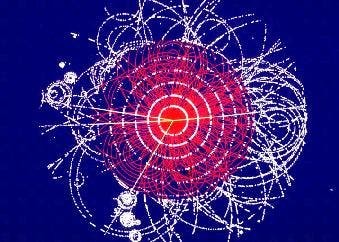What is the Higgs boson?
 Ian Sample and James Randerson
Ian Sample and James Randerson
Named after Peter Higgs, an Edinburgh University physicist, the Higgs boson is crucial to understanding the origin of mass. Shortly after the big bang, it is thought that many particles had no mass, but became heavy later on thanks to the Higgs field. Any particles that interact with this field are given mass. The Higgs boson is the signature particle of the field.
What exactly is the Higgs field?
A theoretical, invisible energy field that stretches throughout the universe. It clings to fundamental particles wherever they are, dragging on them and making them heavy. Some particles find the field more “sticky” than others. Particles of light – photons – are oblivious to it. Other particles have to wade through it like an elephant in tar. So, in theory, particles can weigh nothing, but as soon as the field switched on shortly after the big bang, they got their mass.
Why do people call it the ‘god particle’?
Its theistic nickname was coined by Nobel prizewinning physicist Leon Lederman, but Higgs himself is no fan of the label. “I find it embarrassing because, though I’m not a believer myself, I think it is the kind of misuse of terminology which I think might offend some people.”
According to Higgs, it wasn’t even Lederman’s choice to call it the god particle: “He wanted to refer to it as that ‘goddamn particle’ and his editor wouldn’t let him.”
What would finding the Higgs boson mean for physics?
It would vindicate the so-called Standard Model of physics which envisages that the universe is made from 12 basic building blocks called fundamental particles and governed by four fundamental forces. The existence of the Higgs boson is predicted by the Standard Model but it has yet to be found by experiments. Even if the Higgs is discovered, the Standard Model does not explain everything.
You can read more about the menagerie of particles predicted by the Standard Model here.
How was the data collected?
The data comes from smashing protons together at very high energy in the Large Hadron Collider at the European particle laboratory, Cern. The collisions recreate conditions that have not existed in the universe since just after the big bang. The Astronomer Royal, Sir Martin Rees, put it like this: “the LHC will generate, in a microscopic region where beams of particles collide, a concentration of energy that has never been achieved before – a concentration that mimics, in microcosm, the conditions that prevailed in the universe during the first trillionth of a second after the big bang.”
After each impact, giant detectors scour the subatomic wreckage looking for evidence of new physics.





